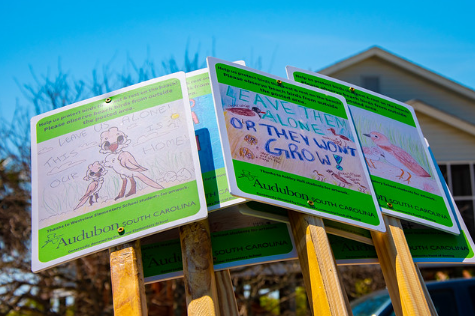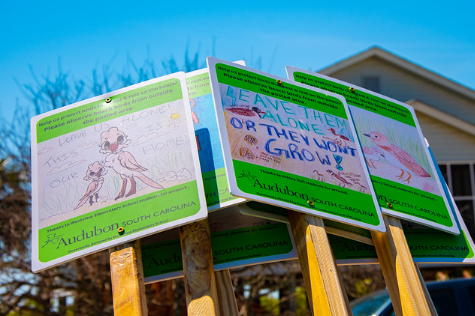CHARLESTON, SC (May 16, 2019) – A series of signs designed by students at Sullivan’s Island Elementary School have been placed along the high tide line and at beach access stations 13 and 16, in an effort to raise awareness to residents and beachgoers about the shoreline’s newest locals, a state threatened bird.
Shorebirds, in general, have declined heavily over the last 40 years – by 70% in North America. That is why projects designed to educate the island are so vital. Every nest counts, and a particular pair of Wilson’s Plovers have taken a liking to Sullivan’s Island.
Wilson’s Plovers have been found nesting and raising young on the island for the past two summers, so Audubon South Carolina, in partnership with the Town of Sullivan’s Island, worked with students at SIES to protect our feathered summer residents this year. Wilson’s Plovers are extremely vulnerable to accidental human disturbances and the newly erected signs aim to educate beachgoers and encourage people to stay out of the area behind the signs.
These birds lay three eggs directly on the sand in small indentations called “scrapes.” Both the mother and father of the soon-to-be baby birds take turns sitting on eggs to shade them from the hot summer sun. Once the eggs hatch, parents also must shade the chicks while they grow their flight feathers and learn how to fend for themselves. When a predator or even a “perceived predator” - like a person or a dog - gets too close to a nest, the parents will hop off the nest and try to lure them away, leaving the well-camouflaged eggs exposed in the meantime. It only takes a minute or two for eggs to perish in the heat.
The posted area is where Wilson’s Plovers have attempted to nest in past years, and biologists say the habitat looks good again this year. “There aren’t many beaches left where it is safe for shorebirds to nest,” says ASC’s Coastal Program Coordinator, Nolan Schillerstrom. “Shorebirds continue to use Sullivan’s Island despite the high number of people and dogs, and every couple of years are successful. We want to give these birds every fighting chance at raising healthy chicks.”
Signs will remain until the end of shorebird nesting season which usually ends sometime between late August and mid-September. Any questions about signage or this program can be directed to Nolan Schillerstrom (nschillerstrom@audubon.org or 843-459-2473).
####
About Audubon South Carolina
Audubon South Carolina protects birds and the places they need, right here in South Carolina. We’re the state office of the National Audubon Society, which has more than one million members and a century-long track record of success. In South Carolina, we represent more than 20,000 Audubon members and supporters, nine Audubon chapters and bird club partners, two Audubon centers and 22,000 acres of land that we own and manage. Learn more about what we do and how to help at sc.audubon.org. Follow us on Facebook at @ScAudubon, Twitter at @AudubonSc, and Instagram at @audubon_sc.
About National Audubon Society
The National Audubon Society protects birds and the places they need, today and tomorrow, throughout the Americas using science, advocacy, education and on-the-ground conservation. Audubon’s state programs, nature centers, chapters and partners have an unparalleled wingspan that reaches millions of people each year to inform, inspire and unite diverse communities in conservation action. Since 1905, Audubon’s vision has been a world in which people and wildlife thrive. Audubon is a nonprofit conservation organization. Learn more at www.audubon.org and @audubonsociety.






